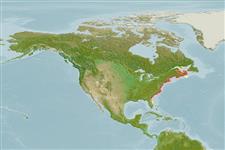Preferred temperature (Ref.
123201): 6.1 - 23.7, mean 9.3 °C (based on 163 cells).
Phylogenetic diversity index (Ref.
82804): PD
50 = 0.5000 [Uniqueness, from 0.5 = low to 2.0 = high].
Bayesian length-weight: a=0.00933 (0.00721 - 0.01208), b=3.17 (3.10 - 3.24), in cm total length, based on LWR estimates for this species (Ref.
93245).
Trophic level (Ref.
69278): 3.6 ±0.48 se; based on food items.
Generation time: 1.5 ( na - na) years. Estimated as median ln(3)/K based on 1
growth studies.
Widerstandsfähigkeit (Ref.
120179): mittel, Verdopplung der Population dauert 1,4 - 4,4 Jahre. (tm<1; tmax=4).
Fishing Vulnerability (Ref.
59153): Low vulnerability (19 of 100).
Nutrients (Ref.
124155): Calcium = 82.9 [39.2, 188.9] mg/100g; Iron = 0.442 [0.225, 0.881] mg/100g; Protein = 17.9 [16.5, 19.2] %; Omega3 = 0.594 [0.249, 1.464] g/100g; Selenium = 4.78 [1.73, 11.60] μg/100g; VitaminA = 29.2 [7.9, 115.4] μg/100g; Zinc = 1.09 [0.70, 1.68] mg/100g (wet weight);
